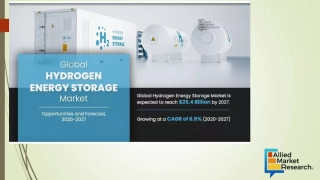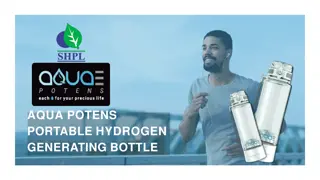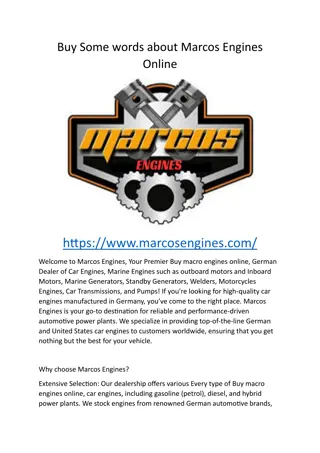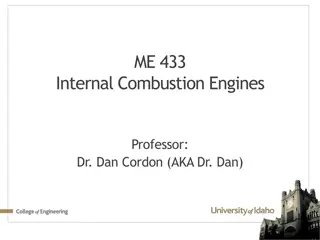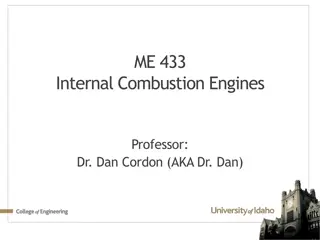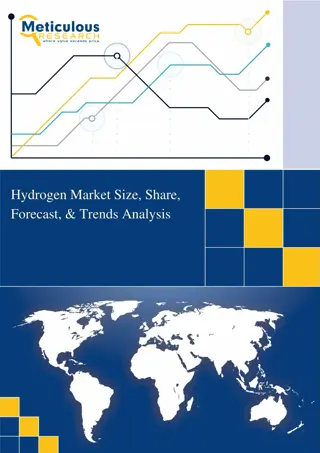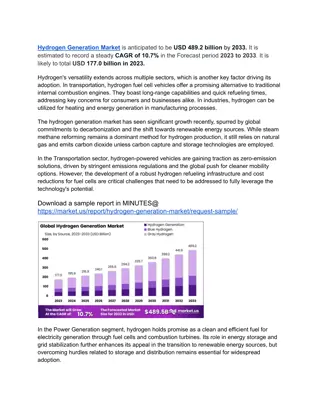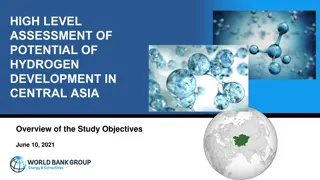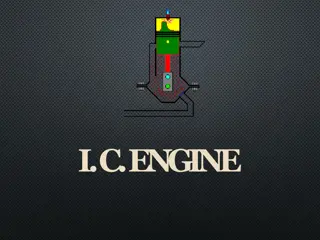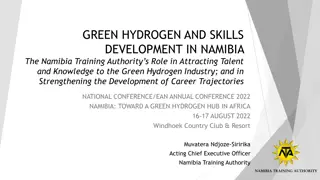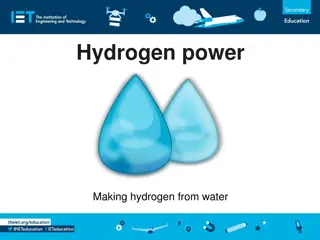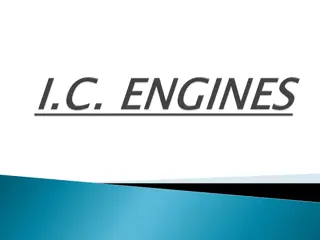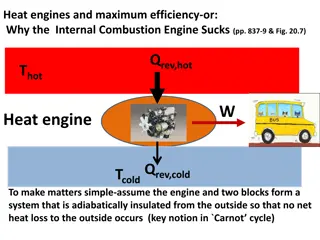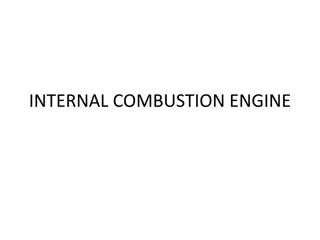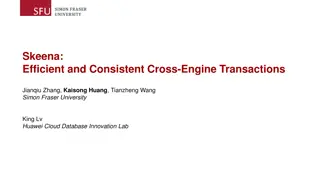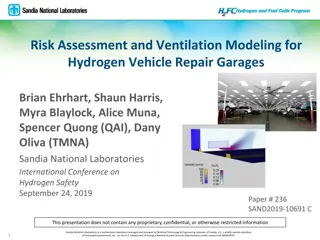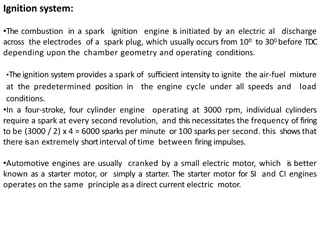Advancements in Hydrogen Combustion for Internal Combustion Engines
Exploring the utilization of hydrogen as a sustainable fuel for internal combustion engines, this research delves into the mixing, combustion, and particulate formation processes in H2ICE. Discussions cover the benefits of hydrogen, challenges faced, and innovative solutions like onboard on-demand hydrogen production. High-pressure thermo-chemical recuperation is highlighted for its performance improvements in engine efficiency and reduction of emissions.
Download Presentation

Please find below an Image/Link to download the presentation.
The content on the website is provided AS IS for your information and personal use only. It may not be sold, licensed, or shared on other websites without obtaining consent from the author.If you encounter any issues during the download, it is possible that the publisher has removed the file from their server.
You are allowed to download the files provided on this website for personal or commercial use, subject to the condition that they are used lawfully. All files are the property of their respective owners.
The content on the website is provided AS IS for your information and personal use only. It may not be sold, licensed, or shared on other websites without obtaining consent from the author.
E N D
Presentation Transcript
Fundamental Hydrogen-Air Mixing, Combustion and Particulate Formation Processes in H2ICE: Particle Formation in Hydrogen Combustion Leonid Tartakovsky Director, Internal Combustion Engines Laboratory Technion Israel Institute of Technology Collaborators: Andy Thawko, Ben Holtzer, Arnon Poran, Amnon Eyal ASME ICED Webinar Series: The Future of the Internal Combustion Engine December 13, 2023
Hydrogen is a Great Sustainable Fuel for IC Engine Carbon-free Wide flammability limits High burning velocity (207 cm/s vs ~35 for gasoline) Thawko et al., Energy Conversion & Management, 2022 Contributes to better antiknock performance Wide-spread opinion: Carbon-free hydrogen combustion in IC engine should lead to performance improvement and emissions reduction Singh et al., Fuel, 2016 2 2
Challenges of Hydrogen as an ICE Fuel No fueling infrastructure available Onboard storage is problematic To remind: ???= 2.016 g/mol, Boiling T = -253 C Because port reformate injection leads to abnormal combustion and power loss, we Can be overcome through onboard on-demand hydrogen production suggested employing the direct injection. 3 3
Onboard on-demand Hydrogen Production From a Sustainable Fuel High-Pressure Thermo-Chemical Recuperation Primary renewable low-carbon intensity liquid fuel (e-fuel) Waste heat recovery process Direct reformate injection Thermo-Chemical Recuperation (TCR) Hydrogen combustion Ultra-low pollutant emissions Methanol Steam Reforming (MSR) CH3OH+H2O 3H2+CO2 H 50 kJ/mol Low reforming temperatures- 250-300 C Tartakovsky L., Sheintuch M., Veinblat M., Thawko A., International Patent Application No. PCT/IB2020/056382, 2021 4 4
High-Pressure Thermo-Chemical Recuperation Performance 0.35 100 90 Engine Performance 0.30 80 Improvement [%] 70 Indicated Efficiency 0.25 60 MSR 50 0.20 40 Gasoline MSR 40 bar MSR 50 bar HP-TCR HP-TCR 19%-30% relative increase in indicated efficiency A reduction in NOx, CO and HC emissions by up to 97, 91 and 96, respectively 30 0.15 20 10 0.10 0 1 2 3 4 5 6 Efficiency CO CO2 HC NOx IMEP [bar] Poran, Thawko et al., Int. J Hydrogen Energy, 2018 5 5
Fuel Type Effect on Gaseous Pollutant Emission DI Engine CO is near-zero for MSR and hydrogen CO2 for MSR - from the injected reformate NOx is near-zero for MSR due to CO2 6 6
Fuel Type Effect on DI Engine Performance HP-TCR system efficiency is higher than HP-TCR system for the pure hydrogen Ultra-low NOx emission for the reformate due to CO2 presence Ultra-low CO emission for both the reformate and hydrogen Advanced EOI is favored because of better fuel-air mixing Thawko et al., Energy Conversion and Management, 2022 7 7
Total Particle Concentration Comparison Thawko et al., Int. J Hydrogen Energy, 2019 Thawko et al., Energy Conversion and Management, 2022 MSR CH3OH+H2O 3H2+CO2 Previously Unknown Phenomenon Why? This result contradicts the previously published data and a straightforward intuition 8 8
Particle Size Distribution Different Oils Higher PN concentration for all particle size with the reformate PM were collected and characterized- lubricant additives were found (b) Oil 2 (synthetic) (a) Oil 1 (mineral) Thawko et al., SAE Technical paper 2020-01-2200 9 9
Particle Formation - Direct vs Port Fuel Injection Single cylinder, Petter AD1 based 80x73 367 15-17.3 Bore x Stroke, mm Displacement, cm3 Compression ratio Power, kW @ speed, rpm 5.3 @ 3000 Direct Port Fuel injection system Increased particles formation for direct injection Excessive lubricant involvement in the combustion 10 10
Under-expanded Gaseous Jet Flow Field Fundamental investigation at ICE typical conditions Goal: Study of the transient underexpanded gaseous jet Detailed flow field characteristics Method: Schlieren & PIV technique for the near- and far-field characterization, respectively Thawko et al., Physics of Fluid, 2021 11 11
Flow Field Characterization- Free Flow Jet Radial velocity Axial velocity Streamlines Swirling strength Vorticity I Air entrainment encouraged by the transient under expanded jet II Thawko et al., Physics of Fluid, 2021 12 12
Flow Field Characterization- Impinging Jet Swirling strength Vorticity Two rolled-up vortex regions with large- scale motion are formed in the wall jet region The lubricant vapor near cylinder walls entrained into the jet in the free-jet region and participates in the combustion Is this the main entrainment mechanism? 13 13
Interaction of a Gaseous Impinging Jet with a Heated Lubricated Surface Several experiments were performed via Shadowgraph optical imaging Z-type configuration Perpendicular impinging jets were traced along the free, piston and liner jet regimes for further understanding of the entrainment mechanism The jets were injected onto heated piston and lubricated liner like surfaces to clarify the lubricant vapor entrainment phenomena Holtzer & Tartakovsky, SAE Technical Paper 2023-01-0308, 2023 14 14
Main Lubricant Entrainment Mechanism Recirculation entrainment of the lubricant vapor in the free-jet region Sweeping is the main entrainment mechanism Sweeping entrainment of the lubricant vapor along the liner by the climbing roll-up Holtzer & Tartakovsky, SAE Technical Paper 2023-01-0308, 2023 15 15
Particle Formation Mechanism in Non-premixed Combustion Thawko & Tartakovsky, Fuel, 2022 Rogers et al. (2015) Hydrogen low quenching distance Both for DI&PFI Excessive lubricant evaporation Lubricant entrainment into combustion chamber bulk Particle formation Holtzer & Tartakovsky (2023) 16 16
Particle Formation - Ignition Timing Effect Reformate fuel Advanced ignition increase in PN concentration Higher In-cylinder pressure followed by lower flame quenching distance More intensive lubricant evaporation More Lubricated surface exposed to flame Thawko et al., Int. J Hydrogen Energy, 2019 17 17
Non-premixed Combustion of Gaseous Fuel - Fuel Type Effect on Particle Emission Thawko & Tartakovsky, Fuel, 2022 Thawko et al., Energy Conversion and Management, 2022 The fuel carbon content is the dominant influencing factor affecting Flame Quenching Distance particle formation at low loads The lubricant becomes the dominant particle source with hydrogen-based Formation in a Particle fuel combustion DI ICE Reformate with the highest injection Duration Injection Fuel Carbon Content duration results in the highest particle formation 18 18
Summary Excessive particle formation was discovered in reformate/hydrogen combustion compared to hydrocarbon fuels Particle formation mechanism in non-remixed hydrogen combustion was described Sweeping is the main lubricant vapor entrainment mechanism into the combustion chamber bulk Longer injection duration results in a higher particle formation The described particle formation mechanism paves the way to development of novel engineering solutions aimed at particle formation mitigation 19 19
Acknowledgments 20 20
Q & A Thank you for your attention! Prof. Leonid Tartakovsky tartak@technion.ac.il 21 21


